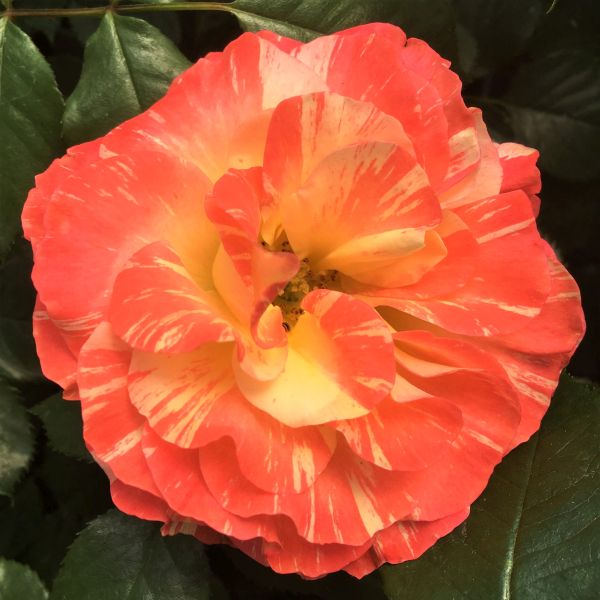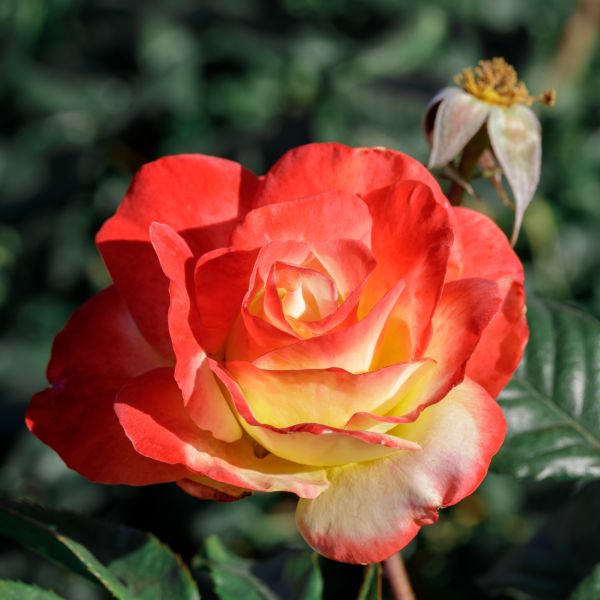

Chihuly Rose
Rosa 'WEKscemala'
91 reviews
Chihuly Rose
Rosa 'WEKscemala'
91 reviews
- Hand-blown using traditional glassblowing techniques
- Vibrant and intricate design adds a pop of color to any space
- Crafted by world-renowned glass artist Dale Chihuly
- Recommended by landscape designers for optimal fit in real yards
$157.00
$225.00
30% Off
- Ships to in 7-10 Days
- Free Shipping
- Plant Arrival Guarantee
- In Stock
- Free Plant Consult
$200 - Landscape-Approved: Every Plant We Sell Comes With Design Expertise Behind It
2.5 Gallon
We are sorry, product is currently out of stock due to seasonal availability. Please check the "Related plants available in your area" section below
Not just beautiful - intentionally selected by ShrubHub's 3D landscape design team to fit real-world spaces and maximize yard potential.
Why Chihuly Rose?
Chihuly Rose is a stunning rose variety developed by Tom Carruth in honor of the famous glass artist Dale Chihuly. Its large, fragrant blooms feature fiery orange and yellow hues with subtle shades of pink and red. This hybrid tea rose is disease-resistant and blooms repeatedly throughout the season, making it a popular choice for gardeners and flower enthusiasts. Its striking beauty and distinctive coloring make it an exceptional addition to any landscape.
Sunlight
Chihuly Rose requires full sunlight or at least six hours of direct sunlight per day for optimal growth and blooming.
Watering
The watering requirement for Chihuly Rose is regular watering, with a focus on keeping the soil consistently moist but not waterlogged.
Fertilizing
The fertilizer requirement for Chihuly Rose is a well-balanced fertilizer with a ratio of nitrogen (N), phosphorus (P), and potassium (K).
Venture into the realm of artistic horticulture with the Chihuly Rose, an embodiment of nature's vibrant and captivating palette. Within this rose lies a fusion of artistry and botanical brilliance, elevating it to a revered status among enthusiasts and garden aficionados.
Picture your garden graced with ruffled, velvety petals painted in a kaleidoscope of hues, reminiscent of the vibrant glass sculptures of renowned artist Dale Chihuly. The Chihuly Rose is a living masterpiece, a testament to the marvels that nature's palette can create.
Caring for this rose is akin to nurturing a work of art. Its multifaceted blossoms demand thoughtful pruning and regular nourishment to maintain their intricate patterns and vivid colors. However, the effort invested is rewarded tenfold when the Chihuly Rose unveils its spectacular blooms, capturing the essence of botanical artistry.
This variety pays homage to its namesake, encapsulating the essence of creativity and ingenuity in horticultural form. The Chihuly Rose is a testament to the boundless possibilities that exist within the world of roses, where aesthetics and artistic inspiration merge seamlessly.
Plant Information:
| Botanical Name: | Rosa 'WEKscemala' |
| USDA Zones: | 6 - 10 |
| Water: | Moderate |
| Exposure: | Full Sun |
| Soil Needs: | Well Drained |
| Mature Height: | 3 - 4 feet |
| Mature Spread: | 3 - 4 feet |






Pollination Info
Pollination Information for Chihuly Rose (Rosa 'WEKscemala')
The Chihuly Rose (Rosa 'WEKscemala') is a hybrid tea rose created by Tom Carruth in 2004. Like all roses, it requires pollination to produce seeds and fruit. Rose flowers have both male and female reproductive parts, making them self-fertile, but cross-pollination by insects and other animals is also important for genetic diversity and plant health.
Pollinators:
Bees are the primary pollinators of Chihuly Rose, but butterflies, moths, and other insects may also visit the flowers for nectar and pollen.
Pollination Process:
When a pollinator visits a Chihuly Rose flower, it collects pollen from the anthers (the male reproductive organs) onto its body or legs. As it moves to another flower, some of the pollen may be transferred to the stigma (the female reproductive organ) of that flower. The pollen then travels down the style to the ovary, where fertilization occurs and a seed develops.
Pollination Tips:
- Plant other flowering plants nearby to attract pollinators.
- Avoid using pesticides that may harm or repel pollinators.
- Deadhead (remove) spent flowers to encourage more blooms and prolong the flowering season.
- Prune in late winter or early spring to promote new growth and flower production.
Overall, pollination is a crucial process for the Chihuly Rose and other plants to reproduce and thrive. Encouraging pollinators and maintaining healthy growing conditions can lead to a more beautiful and bountiful garden.
FAQ
FAQ for Chihuly Rose (Rosa 'WEKscemala')
What is Chihuly Rose?
Chihuly Rose is a new hybrid tea rose variety developed by the world-renowned rose breeder, Tom Carruth, in 2006. It is named after the famous glass artist Dale Chihuly, who created a series of stunning glass sculptures inspired by the rose's vivid colors.
What is the origin of Chihuly Rose?
Chihuly Rose is a result of a cross between two popular rose varieties - 'Julia Child' and 'New Zealand' - carried out by Tom Carruth at Weeks Roses in California. It took several years of careful selection and propagation to achieve the desired attributes, such as strong growth, healthy foliage, and vibrant blooms.
What are the characteristics of Chihuly Rose?
Chihuly Rose is a vigorous bushy rose that can grow up to 4 feet tall and 3 feet wide. It has glossy dark green leaves that provide an excellent backdrop for the luminous flowers. The blooms are large and double, with a high-centered form and ruffled edges. The petals are yellow, orange, and pink, and they intensify in color as they age, creating a dynamic effect. The fragrance is sweet and spicy, with hints of citrus and honey.
How do I plant and care for Chihuly Rose?
Chihuly Rose is a relatively easy rose to grow and care for. It prefers full sun exposure (at least 6 hours of direct sunlight per day) and well-draining soil with a pH of 6.0 to 6.5. Plant it in a location with good air circulation to prevent fungal diseases. Water deeply but infrequently, and avoid wetting the leaves. Fertilize in the spring with a balanced slow-release rose fertilizer, and supplement with liquid fertilizer during the blooming season. Prune in late winter or early spring to remove dead or diseased wood, and to promote vigorous new growth.
Can Chihuly Rose be grown in containers?
Yes, Chihuly Rose can be grown in containers as long as the container is large enough to accommodate the root system and provide adequate drainage. Use a good quality potting mix and add organic matter to improve the soil's structure and water-holding capacity. Place the container in a sunny location and water regularly but be careful not to overwater.
Does Chihuly Rose have any pests or diseases?
Like most roses, Chihuly Rose is susceptible to certain pests and diseases. Common pests include aphids, thrips, spider mites, and Japanese beetles. Some diseases that may affect it are black spot, powdery mildew, and rust. To prevent and control these problems, monitor your rose regularly, and take action promptly. Use insecticidal soap or neem oil for pests, and fungicides for diseases. Remove and destroy any infected foliage or wood to prevent the spread.
When does Chihuly Rose bloom?
Chihuly Rose blooms profusely from late spring to fall, with a peak flush in mid-summer. The exact flowering time may vary depending on the climate and location.
Where can I buy Chihuly Rose?
Chihuly Rose is widely available at nurseries, garden centers, and online retailers, such as David Austin Roses, Jackson and Perkins, and Nature Hills Nursery. You can also order it directly from the hybridizer, Weeks Roses.
Planting & Care
Planting & Care for Chihuly Rose
Planting
- Choose a site that receives at least 6 hours of full sunlight per day.
- Prepare the soil by digging a hole that is twice as wide and just as deep as the root ball.
- Mix in compost or aged manure to improve soil quality and drainage.
- Remove the rose from its container and gently loosen any tangled roots.
- Place the rose in the hole and backfill with soil, making sure the graft union (the knobby part where the rose is grafted onto the rootstock) is at or just above the soil level.
- Water thoroughly and top with a layer of mulch to retain moisture.
Care
- Water deeply once a week, more during hot weather or if rainfall is scarce.
- Fertilize in early spring with a balanced fertilizer, following package instructions.
- Prune in late winter or early spring to remove dead or damaged wood and shape the plant if necessary.
- Monitor the rose for common pests such as aphids, thrips, and spider mites, and treat with an appropriate insecticide if necessary.
- Watch for signs of disease such as black spot, powdery mildew, or rust, and treat with a fungicide if necessary.
- Enjoy the stunning blooms of the Chihuly Rose throughout the growing season, and consider deadheading (removing spent blooms) to encourage more flowering.
Check Out These Verified Customer Reviews:
Customer Reviews
4.7 out of 5 based on 91 reviews
Thank you! Your review has been submitted.
The Chihuly Rose is a lovely addition to my collection. The website was easy to navigate and ordering was a breeze.
Fast shipment, arrived earlier than expected
Breathtaking! The Chihuly Rose exceeded my expectations. Will definitely be purchasing more from this seller.
Item has been added to your cart.


